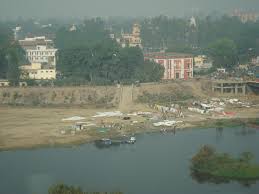
This river is also called Dhenumati [dhenu = go = cow]. Go also means water. So this river has plenty of water. This river flows from Himalayas and should not be confused with Gomati river in Dwaraka, where the river flows West. Here, Gomati river mixes with Ganga, near Kanpur. Lord Brahma started creation. First Swayambhu Manu was created. He married Shatarupa. They had Priyamvrata and Uttanapada, as sons. Uttanapada was the father of legendary Druva. Priyamvrata had Agnitra, Madi, Rishabadeva, Jata Bharata, etc.. as children. Swayambu Manu also had daughters Devahuti, Aahuti and Prasuti. Kardama Prajapati married Devahuti and their child was Kapila, who was the founder of Sankya philosophy. Shatarupa, used to bathe in this river and worship the Lord, in the form of forest, and was blessed to marry Swayambu Manu. We will now see slokas 31 and 32, in which Rajasa Buddhi and Tamasa Buddhi are explained by the Lord. We have already seen what Satvika Buddhi is. It is the intellect or Buddhi, which conveys the true form. It guides the Dharma to obtain wealth in this world and Moksham. It also guides to activities to be done [Karya] and activities to be abandoned [Akarya]. It also reveals which are to be afraid of and which are not. These were stated in sloka 30. Now, sloka 31:
yayā dharmam adharmaṃ ca kāryaṃ cākāryam eva ca
ayathāvat prajānāti buddhiḥ sā pārtha rājasī 18.31
Partha = Arjuna, sa buddhi = that intellect is, rajasi = Rajasa [Buddhi]. Yaya = by which [buddhi], dharmam adharmam = misunderstands Dharma as Adharma. By Satvika Buddhi, one understands Dharma as Dharma and Adharma as Adharma. That is the true nature was shown. Here, confusion prevails, in Rajasa Buddhi. Karyam ca akaryam eva = mistakes between do's and don'ts. Here, this buddhi guides the person to do action, which should not be done and vice versa. Ayathavat = reversing the true nature. By this one mistakes one for another. Prajanati = [like this] guides to understand. So, Rajasa Buddhi guides:
- To mistake Dharma for Adharma.
- To provoke to do an action not to be done, and vice versa.
- To misunderstand one for another, by suppressing the true nature.
adharmaṃ dharmam iti yā manyate tamasāvṛtā
sarvārthān viparītāñś ca buddhiḥ sā pārtha tāmasī 18.32
Partha = Arjuna, sa buddhi = that buddhi is, tamasi = Tamasa [Buddhi]. Tamasavrta = [an atma] surrounded by Tamas quality, manyate = understands, adharmam dharmam iti = understands Adharma as Dharma. In Rajasa Buddhi, Dharma was shown as Adharma. This Tamasa Buddhi nature we could see in thieves, robbers, terrorists, etc., who maintain that all their bad activities were Dharma. Sarvarthan = all matters are, viparitan ca = indicated wrongly. This Buddhi will guide to understand wrongly all things. Instead of appreciating Lord's auspicious qualities, it will guide to describe them as illusion. Tamasa Buddhi will guide:
- Adharma as Dharma.
- Misapprehand matters.
No comments:
Post a Comment